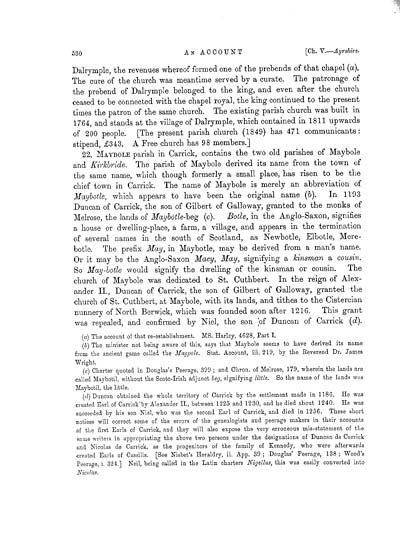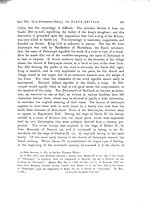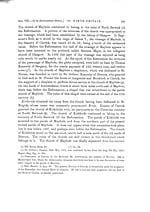Volume 6
(88) Page 530
Download files
Individual page:
Thumbnail gallery: Grid view | List view

530 Dalrymple, the revenues whereof formed one of the prebends of that chapel (a). The cure of the church was meantime served by a curate. The patronage of the prebend of Dalrymple belonged to the king, and even after the church ceased to be connected with the chapel royal, the king continued to the present times the patron of the same church. The existing parish church was built in 1764, and stands at the village of Dalrymple, which contained in 1811 upwards of 200 people. [The present parish church (1849) has 471 communicants: stipend, �343. A Free church has 98 members.] 22. MAYBOLE parish in Carrick, contains the two old parishes of Maybole and Kirkbride. The parish of Maybole derived its name from the town of the same name, which though formerly a small place, has risen to be the chief town in Carrick. The name of Maybole is merely an abbreviation of Maybotle, which appears to have been the original name (6). In 1193 Duncan of Carrick, the son of Gilbert of Galloway, granted to the monks of Melrose, the lands of Maybotle-loeg (c). Botle, in the Anglo-Saxon, signifies a house or dwelling-place, a farm, a village, and appears in the termination of several names in the south of Scotland, as Newbotle, Elbotle, Mere- botle. The prefix May, in Maybotle, may be derived from a man's name. Or it may be the Anglo-Saxon Maey, May, signifying a kinsman a cousin. So May-botle would signify the dwelling of the kinsman or cousin. The church of Maybole was dedicated to St. Cuthbert. In the reign of Alex- ander II., Duncan of Carrick, the son of Gilbert of Galloway, granted the church of St. Cuthbert, at Maybole, with its lands, and tithes to the Cistercian nunnery of North Berwick, which was founded soon after 1216. This grant was repealed, and confirmed by Niel, the son of Duncan of Carrick (d). (a) The account of that re-establishment. MS. Harley, 4628, Part I. (b) The minister not being aware of this, says that Maybole seems to have derived its name from the ancient game called the Maypole, Stat. Account, iii. 219, by the Reverend Dr. James Wright. (c) Charter quoted in Douglas's Peerage, 399 ; and Ohron. of Melrose, 179, wherein the lands are called Maybotil, without the Scoto-Irish adjunct leg, signifying little. So the name of the lands was Maybotil, the little. (d) Duncan obtained the whole territory of Carrick by the settlement made in 1186. He was created Earl of Carrick by Alexander II., between 1225 and 1230, and he died about 1240. He was succeeded by his son Niel, who was the second Earl of Carrick, and died in 1256. These short notices will correct some of the errors of the genealogists and peerage makers in their accounts af the first Earls of Carrick, and they will also expose the very erroneous mis-statement of the same writers in appropriating the above two persons under the designations of Duncan de Oarrick and Nicolas de Carrick, as the progenitors of the family of Kennedy, who were afterwards created Earls of Cassilis. [See Nisbet's Heraldry, ii. App. 39 ; Douglas' Peerage, 138 ; Wood's Peerage, i. 324.] Neil, being called in the Latin charters Nigellus, this was easily converted into Nicolas.
Set display mode to:
![]() Universal Viewer |
Universal Viewer | ![]() Mirador |
Large image | Transcription
Mirador |
Large image | Transcription
Images and transcriptions on this page, including medium image downloads, may be used under the Creative Commons Attribution 4.0 International Licence unless otherwise stated. ![]()
| Caledonia, or, An account, historical and topographic of North Britain from the most ancient to the present times > Volume 6 > (88) Page 530 |
|---|
| Permanent URL | https://digital.nls.uk/74531206 |
|---|---|
| Description | Vol. VI. |
|---|---|
| Attribution and copyright: |
|

